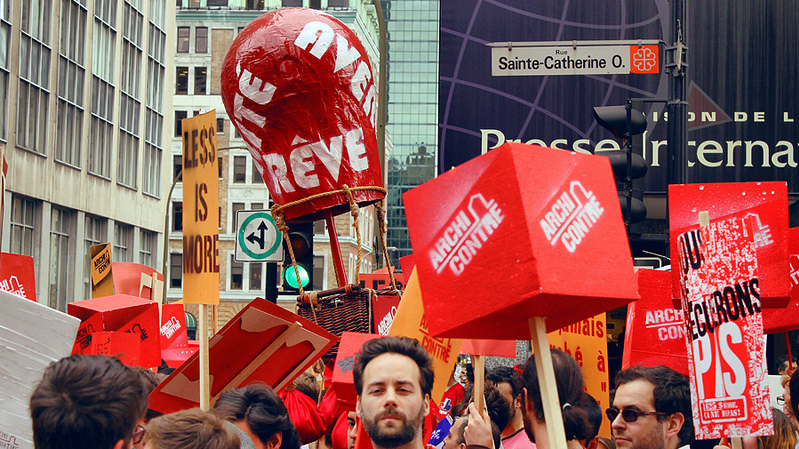
(MintPress) – “We want to study, not go into debt!” That was the rally cry of tens of thousands of protesters in Quebec, Canada as demonstrations flared up against a 75 percent tuition increase for the province’s universities. Over the next five years, the government in Quebec plans to raise tuition by $1,625 – current tuition is $2,200. While the increase in Quebec is a dramatically higher hike than normally seen, increases in tuition have become a yearly norm for students in the United States, where students can expect exponential percentage increases from year to year.
Quebec argues that the drastic hike is necessary for the province to catch up to college costs in other areas of Canada. Ontario charges the highest tuition in Canada at $6,640, and Quebec is looking to find a middle ground between its rock-bottom prices and the country’s highest tuition. Quebec says it wants to be completely caught up with the average Canadian tuition by 2020. Quebec government is currently combating a $2.4 billion budget deficit, and is looking to use the tuition increase as a way to make up for reductions to education subsidies.
While the effects of the long-term tuition hike have yet to be seen, students worry that the hike will make college less affordable and, in turn, less attainable for those looking into higher education. Many students acknowledge that tuition increases are inevitable with rising costs, but as one protester in Montreal, Marc-Andre Levesque, told a media outlet, the tuition spike is “too much, too soon.”
In late February, more than 65,000 students staged a strike and walked out of classrooms to protest the 75 percent increase. Since the protests have begun, nearly 300,000 have demonstrated against the government. The government in Quebec has not stepped back on its plan, however. The first wave of fee increases is expected to be felt this fall.
A mirror of America
Across the border in the U.S., a similar revolt took place against rising tuition rates when “Occupy Education” organized movements across the country to raise awareness of the public education system. On March 1, a “day of action” saw thousands of students walk out of their classrooms in protest of rising tuitions and fees.
“We refuse to accept educational re-segregation, massive tuition increases, outrageous student debt, and increasing privatization and corporatization,” the group’s website said.
Comparatively, the average yearly combined tuition and fees increase in America for a four-year university is nearly 8.3 percent for in-state students and 5.7 for out-of-state students between 2010 and 2012.
These increases have put a damper on students when they must choose which college to attend. A survey by the Higher Education Research Institute at the University of California, Los Angeles (UCLA) found that the percentage of students who were attending their first choice of school was down to 57.9 percent in 2011 from 60.5 percent in 2010, the lowest percentage the study has come across since 1974.
The study also detailed that one of the main culprits for this decline was the rising cost of college. 1 in 5 students surveyed said they had to turn down their first choice because it was too expensive. The fear of student loans and payback also showed, as 52.5 percent of respondents used student loans as a means to pay for college, while 78.3 percent received funding through family resources.
Rising college costs certainly are not new, and have grown into an issue even prior to the recession. A report from the National Center for Public Policy and Higher Education highlights that between 1982 and 2007, tuition and fees at colleges in the U.S. rose 439 percent while the median income for a family rose 147 percent.
Patrick M. Callan, president of the center, said the current college system is unsustainable for both the institutions and those that have to pay their way through school.
“If we go on this way for another 25 years, we won’t have an affordable system of higher education,” Callan told the New York Times.
The alternative, according to Callan, is worse. If people do not go to college because the cost is too high, then the workforce suffers because there are fewer educated people to fill demanding roles. He said the U.S. is seeing it already today.
“When we come out of the recession we’re really going to be in jeopardy, because the educational gap between our work force and the rest of the world will make it very hard to be competitive,” Callan said. “Already, we’re one of the few countries where 25- to 34-year-olds are less educated than older workers.”
A popular model to help students fund college has been the use of state grants, but as college prices have risen quicker than family incomes, more students are qualifying for the need-based grants and running states thin. Recently, the state of Illinois ran out of funding for its Monetary Award Program (MAP) grant, the earliest it has ever happened, because of the increase in students applying for it.
John Samuels, spokesman for the Illinois Student Assistance Commission (ISAC), told the Chicago Tribune that the depletion of funds was “a sign of incredible demand more than anything else.”
Why is tuition exponentially increasing?
In Canada, Quebec made it clear that the rise in tuition costs was to put the province on par with other provinces’ college rates. In America, year-to-year tuition increases are more complex, and without clear-cut reasons, speculation abounds.
Richard Vedder, economics professor at Ohio University, wrote that colleges and universities in America do not have to worry about maintaining reasonable college prices because Americans are so willing to put themselves into debt to obtain a college degree.
“Like health care, prices are rising rapidly for higher education because of the predominant role of third-party payments – federal student loans and grants, state government support for institutions and students, private philanthropic gifts and endowment income,” Vedder wrote.
He adds, “College seniors who borrow to finance their education now graduate with an average of $24,000 in debt … When someone else is paying a lot of the bills, students are less sensitive to the price, thus allowing the colleges to care less about keeping prices under control.”
George Washington University professor Sandy Baum agrees, saying that states are covering less of the college costs, leaving students to make up for the price increases that were once absorbed by the state. Baum also told Nation Public Radio that universities simply are not focusing on efficiencies as much as other adjusting industries are.
The state of Oregon proposed a 7.5 percent tuition increase for seven of its colleges and universities, saying that the cost to run a school is getting more expensive with time, just like anything else. One official for Oregon’s Board of Higher Education said the increases are needed, but that schools are always looking for ways to cut costs.
“We are taking that seriously and trying to manage our costs,” said Jay Kenton, the board’s vice chancellor for finance and administration. “We have been very careful and working closely with our students to make sure we don’t price people out of an education.”
Callan said that may be too late, which is why federal and private loans have become so prevalent in America to fund college degrees. Outstanding student loans in America have exceeded $1 trillion and now account for more debt in the U.S. than credit cards. In 2010 alone, students took out $1 billion in student loans.
“The middle class has been financing (college) through debt,” Callan said. “The scenario has been that families that have a history of sending kids to college will do whatever it takes, even if that means a huge amount of debt.”


